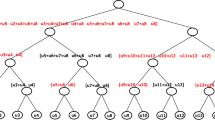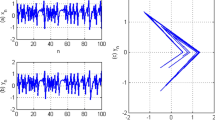Abstract
In this paper, the performance of punctured convolutional codes of short constraint lengths is discussed. The punctured codes are used to provide error protection to a particular user in an asynchronous CDMA system. A perfect phase reference is assumed to be available throughout this paper. A slow fading Rician channel is assumed. Maximum likelihood decoding through a Viterbi algorithm is used to decode the information symbols. Soft-decision decoding of punctured convolutional codes is considered in this paper. The upper bounds with Viterbi decoding are derived and plotted for the various punctured codes considered. The simulated results are found to agree very well with their upper and lower bounds.







Similar content being viewed by others
REFERENCES
T. S. Rappaport, Wireless Communications: Principles and Practice, Prentice Hall, Inc., 1996
Proakis J. G. (2001). Digital Communications. McGraw Hill, NY. fourth edition
X. Wang and H. Vincent Poor, Iterative (turbo) soft interference cancellation and decoding for coded CDMA, IEEE Transactions on Communications, Vol. 47, No. 7, pp. 1046–1061, July 1999
Z. Shi and C. Schlegel, Joint iterative decoding of serially concatenated error control coded CDMA, IEEE Journals on Selected Areas in Communications, Vol. 19, No. 8, Aug. 2001
Earnshaw A., Blostein S. (2000). A combined soft-decision deinterleaver/decoder for the IS-95 reverse link. IEEE Transactions on Vehicular Technology 49(2):448–456
Chen Q., Sousa E., Pasupathy, S. (1995). Performance of coded multi-carrier DS-CDMA system in multipath fading channels. Wireless Personal Communications 2:167–183
A. Elezabi and A. Duel-Hallen, Two-stage detection of coded CDMA systems and a novel interleaving scheme, Second IEEE Symposium on Computers and Communications (ISCC ’97), pp. 551–555, July 1997
G. Aliftiras, Receiver implementation for a CDMA cellular system, Ph.D thesis, Virginia Polytechnic Institute and State University, July 1996
K. Kettunen, Soft detection & decoding in wideband CDMA systems, Ph.D thesis, Helsinki University of Technology, Mar. 2003
A. Cameron Rick, Fixed-point implementation of a multi-stage receiver, Ph.D thesis, Virginia Polytechnic Institute and State University, Jan. 1997
P. Xiao, Iterative detection, decoding and channel parameter estimation for orthogonally modulated DS-CDMA systems, Ph.D thesis, Chalmers University of Technology, Goteberg, 2004
Lee L. (1994). New rate-compatible punctured convolutional codes for Viterbi decoding. IEEE Transactions on Communications 42(12):3073–3079
Modestino J. W., Mui S. Y. (1976). Convolutional code performance in the Rician fading channel. IEEE Transactions on Communications 24(6):592–606
S. B. Wicker, Error Control Systems for Digital Communications and Storage, Prentice Hall, 1995
Wozencraft J., Jacobs I. (1965). Principles of Communication Engineering. Wiley, NY
Author information
Authors and Affiliations
Corresponding author
Rights and permissions
About this article
Cite this article
Bhaskar, V. Soft-Decision Decoding of Punctured Convolutional Codes in Asynchronous-CDMA Communications Under Perfect Phase-Tracking Conditions. Int J Wireless Inf Networks 13, 229–237 (2006). https://doi.org/10.1007/s10776-006-0025-2
Published:
Issue Date:
DOI: https://doi.org/10.1007/s10776-006-0025-2




